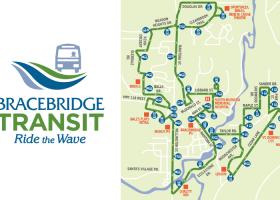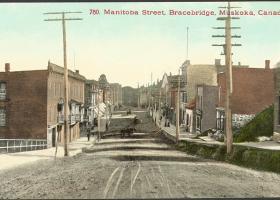History of Bracebridge
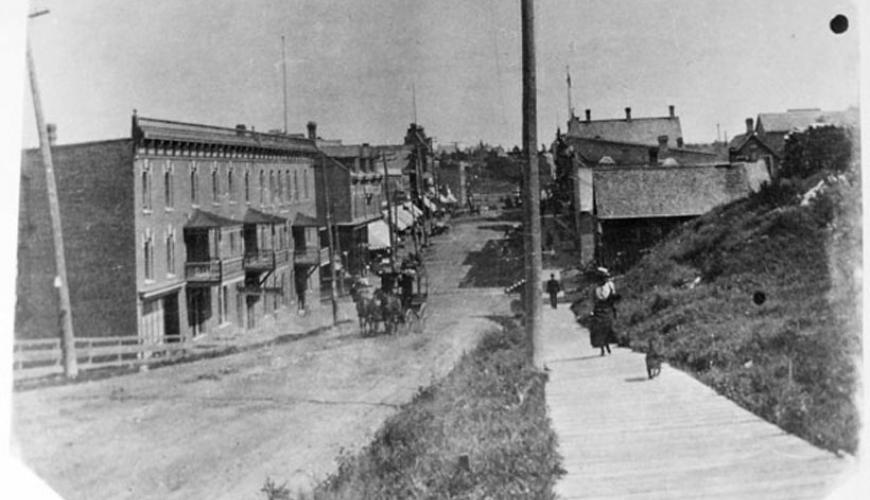
The character of the town of Bracebridge is shaped by its proximity to Lake Muskoka to which it is connected by 6 miles of the Muskoka River, and by the promise of abundant water power afforded by the great waterfall at the foot of the town. Early growth of the town occurred in proximity to the falls which powered the first factory. The arrival of the Grand Trunk Railway cemented the town's role as a transportation hub for the area.
The Bracebridge train station was a stop for Northlander trains of Ontario Northland until service was discontinued on September 28, 2012.
The Muskoka Road, most of which now forms Highway 11, was constructed in the late 1850s and early 1860s, quickly becoming the primary trunk road to Lake Nipissing. A series of towns eventually would flourish along its length, but the first of these was Bracebridge. East of Muskoka Falls, Thomas J. McMurray established a 400-acre (1,600,000 m2) townsite in the spring of 1861 at the intersection of the Muskoka Road and Peterson Road.
Construction on the Muskoka Road began in 1858. At the time of Bracebridge's founding, the road did not extend beyond the Muskoka River. It was opened as far as Sundridge by 1875. Today Highway 11 follows a majority of the route, but bypasses it in several locations, notably between Bracebridge and Huntsville.
Modern settlement of the town began in the 1860s, beginning at first with a few log huts. The Muskoka colonization road had been completed to the first falls on the north branch of the Muskoka River by 1862. Entrepreneurs began to take advantage of the area's water power. With the advent of steamship service on Lake Muskoka a few years later, Bracebridge prospered as the main distribution centre for the region.
By 1869, Bracebridge was a village with a population of 160 in the Township of Macaulay County, Victoria. It was established on the Muskoka River. There were stages in winter and boats in summer from Barrie to Washago. The average price of wild land was $2 to $5 an acre while improved land was $10 per acre.
By 1870 the village had a population of about 400, growing to reach a total of about 2,000 by the turn of the 20th century. The village was incorporated in 1875 and became a town under an Act of Parliament in 1889.
On October 5, 1894 the Bracebridge Village Council purchased a water power generating plant to supply electricity to the community and in so doing made Bracebridge the pioneer in municipal hydro-electric generation in Canada. The generator was 84 kilowatts and housed in the building which still stands at Bird's Mill.
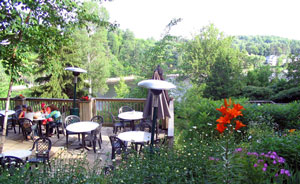 Inn at the Falls
Inn at the Falls
The "Main Inn" was originally a Victorian private residence built by English stonemasons in the mid 1870s. William C. Mahaffy, a land surveyor, purchased the property some 10 years later. In 1888, he was appointed the first District Judge of the area and his home and family became an integral part of the social and economic history of Muskoka. Many distinguishing features of the old structure have been preserved including the century old fireplace in the Parlor, with its distinctive "Egg and Dart" design and the carved wooden banister in the main entrance. The foundation walls of the main inn are over three feet thick. In 1943, the home was converted to an Inn and has undergone extensive renovations and mechanical upgrades.
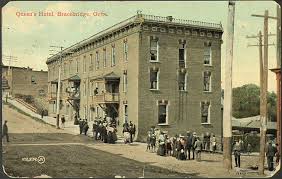 The Queen's Hotel
The Queen's Hotel
The building on this site, known for many years as The Queen's Hotel, was built in 1885 by Alfred Hunt, a local entrepreneur. He owned real estate along Manitoba Street and was a private banker until 1898. In 1892, William Higgins who owned the hotel at that time, constructed a large addition that doubled the size of the building. There were several owners of the hotel until 1944 when it was purchased by the Patterson brothers and renamed the Hotel Patterson
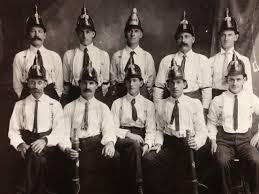 Bracebridge Fire Brigade
Bracebridge Fire Brigade
The first Fire Brigade was established in 1876, with John Haw as Fire Warden. There were approximately 50 firefighters that operated on a $500 to $700 budget. There was an average of 25 fire calls just in this small area each year.
